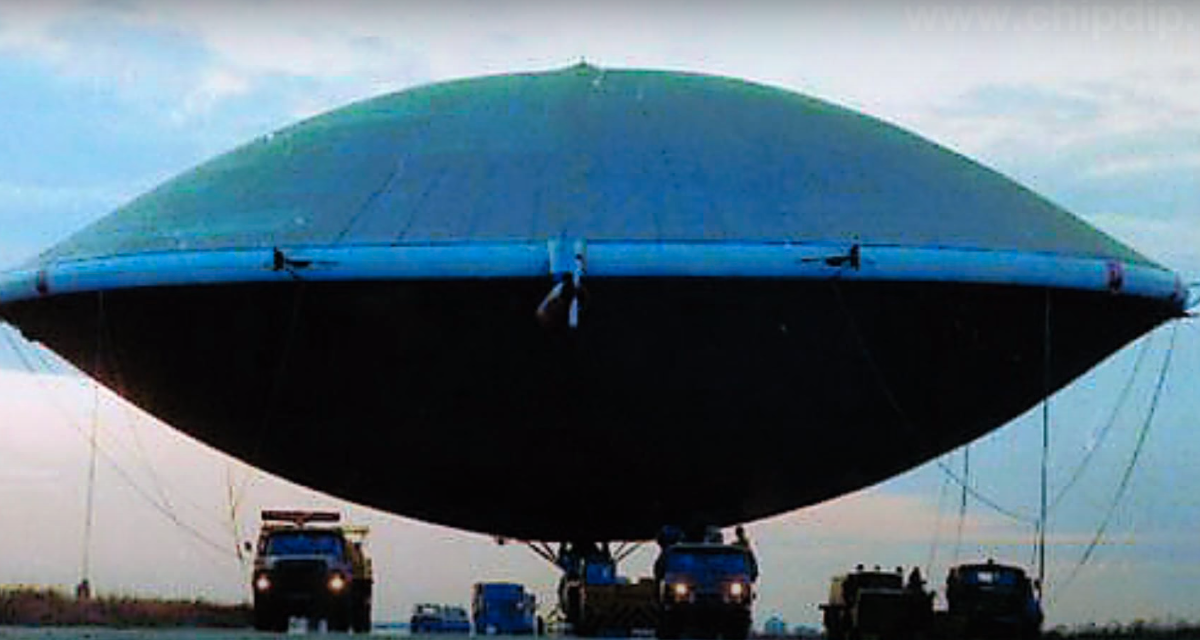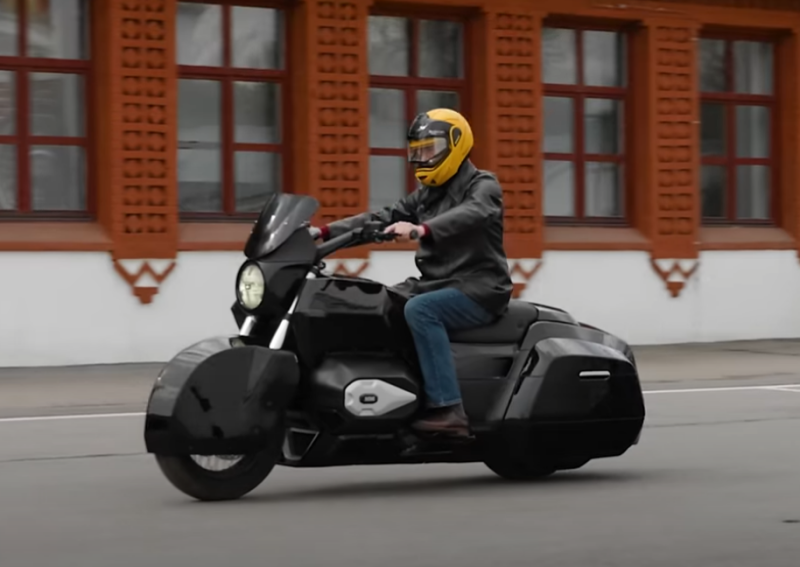EKIP
"Ecology and progress" - this is how the name of the aircraft is deciphered, which in all forms resembles a flying saucer of aliens from outer space. In the West, this project was called “Russian UFO” (Russian UFO).
 Indeed: why not a UFO? Photo: YouTube.com
Indeed: why not a UFO? Photo: YouTube.comDevelopments were carried out over a decade from the 80s to the 90s by several organizations at once, including TsAGI, Energia and others. The head and ideological inspirer was the aviation engineer L. Shchukin.
Design and its features
In the USSR, this "aircraft" was called an ekranolet. Its operation amazed the imagination of an ordinary earthling: during takeoff, the EKIP rose above the airfield, hovered and rapidly soared up. Landing took place in the reverse order: a sharp decline, free soaring in the air, lowering. At the same time, no fantastic elements such as controlled gravity or new types of energy were used.
Engines
The main design feature was to reduce drag and increase stabilization through the so-called. a vortex system that helps control the boundary layer flowing around the EKIP. In addition to it, the control of the apparatus was carried out by flat-nozzle jet devices.
 The radio-controlled model EKIP successfully starts (classified image of the 80s). Photo: YouTube.com
The radio-controlled model EKIP successfully starts (classified image of the 80s). Photo: YouTube.comIn simple terms, special vortex engines ensured a constant air flow around the vessel. Thanks to them, the device took off like an airplane, but the “run-up” with a separation could be carried out over any surface at a height of 3 meters: earth, snow, sand, etc. At the same time, the length of the “GDP” did not exceed 600 m. Even shorter about the principle of operation: some motors blew, raised and lowered the apparatus, others moved forward.
 So the flight of the passenger version of the EKIP was supposed to take place. Photo: YouTube.com
So the flight of the passenger version of the EKIP was supposed to take place. Photo: YouTube.comReal AL-34 engines were developed, operating both on a special type of fuel (water plus emulsion), and on ordinary kerosene or natural gas. The possibility of using hydrogen as a fuel was envisaged.
The power units were located in the rear of the hull. In total there was a pair (possibly more) of traction turbojet engines and the same number of auxiliary ones, which “made” an air cushion for the apparatus. A security system was thought out: if the main installations failed, the EKIP could land at the expense of additional ones. Even if three of the 4 (minimum number) engines fail, which is very unlikely, the ekranolet will still land successfully. Technical data that cannot but surprise:
✅ depending on the model, the EKIP could carry loads weighing 4-120 tons
✅ height range - from 3 to 10 thousand meters
✅ cruising speed - 610 km / h
✅ range - up to 6 thousand km
✅ fuel consumption - 11-20 g per 1 "passenger-kilometer"
✅ capacity - up to 1000 people
Any airfield was suitable for using the “Russian UFO”, however, the presence of which is not necessary for takeoff and landing.
Chassis
In its manufacture, composites were used, thanks to which the ratio of the weight of the empty and loaded apparatus was 30% less than that of aircraft. This meant that the commercial "component" of EKIP is more than that of airliners by the same almost a third. It was possible to use composites without fear about strength, since the ekranolet did not experience the loads that aircraft are subject to. The crew did not have wings (more precisely, they were, but small and formed a single whole with the fuselage) and landing gear. In all modes of operation, the “Russian UFO” experienced pressure comparable to that exerted by a thirty-centimeter layer of water.
 Transport option EKIP. Photo: YouTube.com
Transport option EKIP. Photo: YouTube.comIn fact, the aerodynamic design of the device was a conventional "flying wing" with a fuselage made in the form of a disk and an air cushion instead of a landing gear.
How did it end?
A pair of prototypes L2-1 and L2-2 was built (there were 5 modifications in the project). Both samples passed flight tests, which turned out to be successful (!). At the very least, this proved the effectiveness of the technology and the ideas implemented in the concept. But then - all the same trouble that befell the country in the 90s: lack of funding. In the early 2000s, engineers tried to find financial support in the United States.
 Maybe there are other sponsors? Photo: YouTube.com
Maybe there are other sponsors? Photo: YouTube.comIt was assumed that a factory would be built. However, a condition was put forward on the Russian side: exactly the same enterprise is being created in parallel in the Russian Federation. The American side rejected the proposal. The project was “finished off” by the death of the chief designer Shchukin in 2001.
"Thermoplane"
The beginning of the development of the project is the mid-80s. Then aircraft were required that could deliver heavy loads to the separated northern regions for the development of mineral developments. Someone considers this design an improved airship. Indeed, it used some of the principles of an aircraft filled with gas. But still there were many differences.
 A prototype locomoskyner in flight (2013). Photo: YouTube.com
A prototype locomoskyner in flight (2013). Photo: YouTube.comDesign
Compared to an airship, the Thermoplan is not lighter, but, on the contrary, heavier than air. This device (another, later name - locomoskiner) uses a mixture of aircraft and airship technologies. The shell of the "aircraft" is a reservoir consisting of a pair of compartments. Hydrogen or helium was pumped into the first, and exhaust gases emitted by running engines into the second.
 Locomoskiners will help not only to transport goods, but also to build houses. Photo: YouTube.com
Locomoskiners will help not only to transport goods, but also to build houses. Photo: YouTube.comThe system providing ascent and descent, as well as flight speed, was based on the regulation of the amount of gases. And in order for the device to move horizontally, turbojet engines were used, each of which developed up to 400 “horses”. There was even an idea to adapt nuclear “engines” for these purposes, such as in icebreakers.
About security
The internal cavities of the "tank", filled with helium or hydrogen, had compartments of complex configuration. Thanks to this, no mechanical impact from the outside would drop the apparatus to the ground. Even with damage to all cavities (which is unlikely), the Thermoplan would have reached the landing site thanks to the stock of exhaust gases.
 Locomoskyner design. Photo: YouTube.com
Locomoskyner design. Photo: YouTube.comLater they were abandoned: soot accumulated inside, and the temperature, which reached 700 °, was dangerous for the shell. Instead of gases, heat guns placed inside the cavity began to be used.
Technical, operational data
In the future, the diameter of the apparatus was to be 320 m. The estimated flight range was up to 10 thousand km at a cruising speed of 150 km / h. At the aircraft factory in Ulyanovsk, a prototype (ALA-40) with a diameter of 40 m was assembled. In 1993, it took off 7 m, hung and ... smoothly sank to the ground. In the future, for well-known reasons, funding was stopped. This machine's data:
✅ cost - from 1,5 to 2,5 million "green"
✅ payload weight - up to 3,5 tons
✅ range - up to 1000 km
✅ speed - 120 km / h
The payback period for the project is 6 years. Compared to an airplane, the efficiency in economic terms is 2 times higher, by a helicopter - 20.
What's up with the project today?
Not everything is as bad here as with EKIP. In 2005, they returned to development, improved the project in accordance with the requirements of the time. The new installation, Locomoskainer-03, will be able to transport up to 600 tons of cargo over a distance of up to 3 km. Unlike airships, this device is not afraid of side winds - its body is made of metal. And you can assemble the locomoskiner inside a small room (no super-hangar is required). First, separate elements are docked, from which the “aircraft” is then assembled on the street.
 The project is not forgotten! Photo: YouTube.com
The project is not forgotten! Photo: YouTube.comIn the Russian Federation, the Aerosmena organization is currently involved in the project, which is going to demonstrate an operating aircraft in 2024. There are already potential customers for a new type of aircraft. Strong interest in it is shown in Japan, the USA, Germany. Who will be the first - that and the cards in hand!










